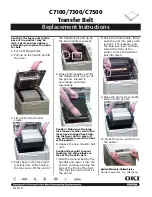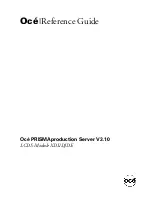
25
Girard Systems
©
2005
Instalation of new fabric
IMPORTANT NOTE: Replacement fabrics are shipped in a rolled condition. The front edge of the
fabric will be marked ‘lead rail end-up’, and will be the leading edge of the roll as you receive it. The
hems will always face downward as the fabric is installed. The other end of this fabric will have
mounted, inside of the hem, a small Poly rope. This end will be mounted into the roller tube. The Poly
rope that was removed from the old fabric at the roller tube will get used for this installation.
1)
Tape the sharp edges of the ‘C’ channel (fabric channel) of the lead rail such that the fabric will
slide and enter freely without snagging or tearing.
2)
Slide the white Poly rope, that was removed from the old fabric, completely into the open, front
hem of the new fabric (marked Lead Rail). The second Poly rope form the old fabric will not be
used in this installation).
3)
The new fabric will need to be unrolled and inserted into both the lead rail, and the roller tube at
the same time. This is done in small even increments about 1-2 feet per pull. You will have to
manipulate the fabric into the roller tube, as it will be a tight squeeze to fit the fabric in because
the limited space to work with. Insert carefully as to not snag or tear fabric. Ensure that the
seams are facing downward. Continue until entire length of fabric has been fed into both roller
tube and lead rail.
4)
Slide the fabric back and forth inside the roller tube to assure the entire length of hem has been
properly inserted. Center the fabric on the roller tube, and square up fabric assembly at lead rail,
i.e., remove wrinkles. Insert self taping screws on both ends of the fabric into roller tube. The
fabric will self-center on the leader rail.
5)
Slowly begin to roll the fabric up, onto the roller tube, using the manual crank. (The motor limit
switches will have to be used, and adjusted if no manual crank is available). Roll the fabric from
the bottom of the roller tube. (See Figure 14)
6)
Using two people, carefully stretch the fabric from end to end during the first few revolutions of
the roller tube, to assure the fabric is rolling straight and true. Continue to slowly roll the fabric
onto the tube until the fabric is taught and in its ‘full extension’ mode against the locked, fully
extended arms. Continue to roll the fabric in, this time using the awning switch and motor.
Watch carefully to assure the fabric rolls straight, and close the awning completely.
7)
Once again, open awning about 18 inches. Pull the leading edge if the fabric taught, from both
ends, and replace both fabric set screws.
Note:
These screws should be located
No Further
than
¾” from the edge of the fabric. Re-drill fabric set screw holes. If necessary with a 1/8” dia. drill
bit, to maintain this distance.
8)
Replace lead rail end cap.
9)
After a fabric replacement, it may be necessary to make minor adjustments to the motor limits
switches to assure that the awning motor stops
exactly
when the box closes (unless using ACL
currant limiting device. Likewise, it is important that the awning motor stops
exactly
when the
awning is extending and the arms ‘snap’ into their full extension position. Please see ‘Adjusting
Motor Limit Switches’
Important Note: The high torque motor which is supplied with the G-2000 awning is designed to
run 4 minutes/hour. The motor has a built-in circuit breaker which is designed to activate if the
motor overheats. The cool down time can be to 1 hour, depending on outside temperature.
Summary of Contents for G-Link G-1500
Page 1: ......
Page 35: ...35 Girard Systems 2005...
Page 39: ...39 Girard Systems 2005 figure 24 MOUNTING AWNING TO WALL MOUNT BRACKETS...
Page 45: ...45 Girard Systems 2005 Figure 30 G 2000 Automatic lateral arm awning system wiring diagram...
Page 62: ...62 Girard Systems 2005...
Page 63: ...63 Girard Systems 2005...
Page 64: ...64 Girard Systems 2005...
Page 65: ...65 Girard Systems 2005...
















































